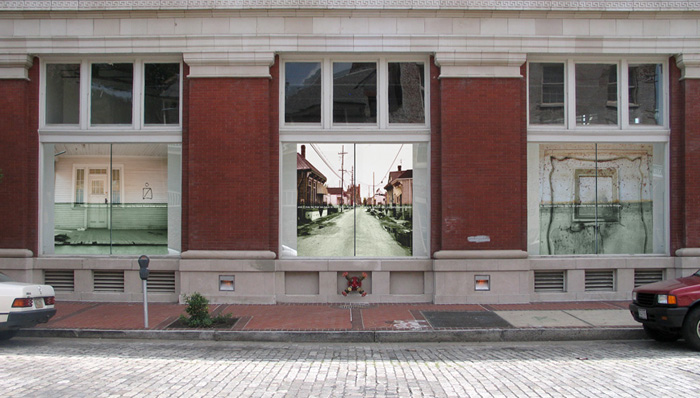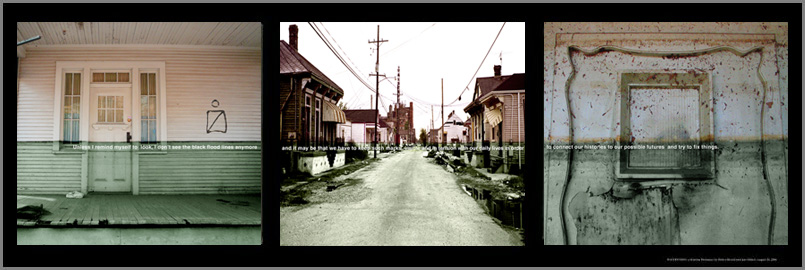

To see more images of the work, click on the individual pages above.
Flood Lines
FLOOD LINES is a collaborative work by Debra Howell, Krista Jurisich and Jan Gilbert, with text by Michelle White.
It was first exhibited as a photolightwork in the windows of the Contemporary Arts Center in New Orleans at the third
anniversary of Hurricane Katrina on August 29th 2008. As backlit panels, each original page is 9'x4.5'.
These large-scale photos are generously sponsored by Ridgway's.
Flood Lines
Jan Gilbert, Debra Howell, and Krista Jurisich invited me (Michele White) to participate in this visual and textual conversation, which appears in the CAC windows, because of an Internet-based text that I wrote about the 2005 flood lines. In it I worried that unless reminded to look, I didn't see the flood lines anymore and that we might have to keep such marks visible and in tension with our daily lives in order to connect our histories to our possible futures and try to fix things. Something has changed from that moment when Spencer Bohren sang "everywhere you look, everywhere you go" the long black lines are visible. This project is an argument for and meditation on seeing the dark, filthy, anger producing, terrifying, and connecting lines.
Every day, people and time are erasing the physical marks of Hurricane Katrina and the flooding of New Orleans. Flood lines are commemorated in varied places by plaques and other memorials, which is a kind of containment and historicizing of the line. Nevertheless, flood lines are scars, traces, and etched reminders. In New Orleans and the surrounding region, they provide a visible map of where the water reached, the places water remained, a stark declaration of "this high" in relationship to homes and bodies, and indications of how drastically and unethically the government and its promised infrastructural system failed. Gilbert's Biography of a House installation, which remapped the lines on her family's Lakeview home by making them into a ribbon-like series of damaged family photos, suggests one of the many stories that the lines include but do not inherently convey. The flood lines are a watermark and chemical and dirt residue but they also contain us, physically wrapping around the city, and include trace quantities of our belongings and the tears, sweat, and excrement of the people caught and killed within the rising deluge.
Lolis Eric Elie wonders about the disappearance of the flood lines, which include those pressure washed off of I-610, and argues that preserving "the filth of old watermarks is probably the wrong way for us to keep alive memories of the federal levee failures." Yet, we can consider the varied meanings of the lines rather than trying to erase them. Like the hair that the Nazis cruelly harvested from people they were exterminating, and used as insulation during WW2, this residue is with us. Thus, we should smartly and politically think about these traces and what we can do with them. The flood lines remain in areas where people have not been able to recover their homes; inside the walls of homes, which may now appear to be cleanly plastered and wall-boarded; and chemically etched on windows.
As people in the region continue to articulate painful gender, race, and class distinctions and forms of intolerance, the flood line is something that we share and need to act upon; but we have to see it. Bohren also notes, "everything is broken except the long black line." However we are breaking the line, not as a way of configuring local and global connections and politics but as a way of making things appear more attractive and avoiding those terrifying marks that are, as he suggests, "sometimes to your knees, sometimes it's to your chest or head, or up above the eaves." We ought to work the line as a second-line--seeing how it connects us, highlighting and performing its histories, acknowledging that it threatened and destroyed some but not all the cultures of New Orleans, and using it to communicate with a country that is also intermeshed in governmental failures and political quandaries. -Michele White